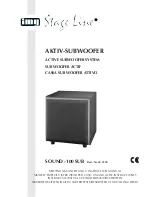
3
Applications
This compact active subwoofer is suited as a low-
frequency complement of existing audio systems
for hi-fi applications, home cinema and home
recording applications. It is equipped with a 25 cm
(10″) bass speaker. Its amplifier offers a peak out-
put power of 200 W.
The subwoofer features an adjustable low pass
filter, a volume control, a phase reversal switch and
an automatic standby mode. The integrated ampli-
fier is provided with protective circuits to prevent
overload and overheating.
Inputs are provided for connection to stereo out-
puts with line level and for connection to speaker
outputs (with feed-through facility for the other
speakers).
The subwoofer also features an LFE input. In
multi-channel systems for cinema applications,
e. g. “5.1”, the LFE channel (“Low Frequency
Effect” or “Low Frequency Enhancement”) is used
for low-frequency special effects.
4
Setting Up and Connecting
Set up the subwoofer on an even surface. It is not
important to place the subwoofer exactly in the mid-
dle between the stereo speakers as it will not be
possible to precisely locate the very low frequen-
cies reproduced by the subwoofer. However, do not
place it too close to walls or in corners; this would
distort the frequency response and prevent the
heat dissipation of the integrated amplifier. Like-
wise, do not cover the bass-reflex openings on the
lower side.
Prior to making connections or changing any exist-
ing connections, switch off the subwoofer and the
units to be connected.
Connect a signal source via one of the three
connection possibilities described in chapters 4.1
to 4.3.
4.1 Stereo input LINE IN
If a stereo output with line level is provided (e. g.
output of a preamplifier or mixer), connect this out-
put to the input LINE IN (7) on the subwoofer. From
the two stereo channels, a mono signal will be
created internally for the subwoofer.
If the outputs of the preamplifier or mixer are
already reserved for your audio system, use an
adapter to divide the output signal (e. g. ACA-120
from MONACOR).
4.2 Stereo input HIGH LEVEL IN
If no output with line level is available, connect the
inputs HIGH LEVEL IN (11) to the speaker outputs
of the amplifier (LEFT = left channel, RIGHT = right
channel). Observe the correct polarity of the con-
nections. When connecting, always switch off the
amplifier. Make sure that the cable ends used for
connection to the screw terminals are only stripped
as far as necessary and that no bare wires stick out
(danger of contact and short circuit). The feed-
through outputs HIGH LEVEL OUT (12) are directly
connected to the corresponding jacks HIGH
LEVEL IN. Use these jacks to connect the other
speaker systems.
There are banana jacks under the protective
caps of the screw terminals.
4.3 Mono input LFE
Connect the LFE output of a multi-channel system
or another mono output with line level to the jack
LFE (8).
Note:
The adjustable low pass filter will not affect
the signal of a signal source connected to this input
as an LFE signal usually contains low-frequency
signals only.
4.4 Power supply
Connect the plug of the mains cable (6) to a mains
socket (230 V~/50 Hz).
WARNING
If an amplifier is connected to the
inputs HIGH LEVEL IN (11), cover all
banana jacks not used with the pro-
tective caps; touching the connec-
tions may result in electric shock.
9
GB










































